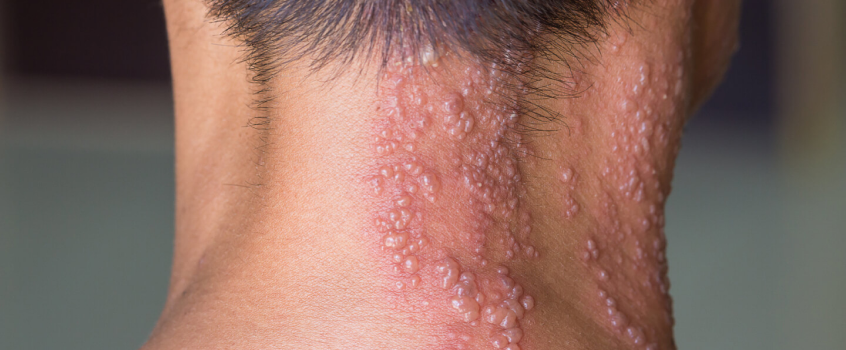Herpes Zoster

Herpes zoster, or shingles, is a painful rash caused by the reactivation of the chickenpox virus.
What is it?
Herpes Zoster, also known as shingles, is a viral infection caused by the reactivation of the varicella-zoster virus (VZV), the same virus responsible for chickenpox. Once a person has had chickenpox, the virus remains dormant in the body’s nerve cells. Later in life, typically when the immune system is weakened or stressed, the virus can reactivate and travel along nerve fibers to the skin, resulting in the painful, blistering rash known as shingles.
Shingles usually manifests as a stripe or band of blisters that appear on one side of the body, often on the torso, face, or neck. Though shingles is not as contagious as chickenpox, it can still spread through direct contact with the rash or fluid from the blisters. People who have never had chickenpox or received the chickenpox vaccine can develop chickenpox if exposed to the virus from someone with shingles.
Herpes zoster primarily affects older adults and those with weakened immune systems, though anyone can develop it. While shingles itself is not life-threatening, it can lead to complications, such as postherpetic neuralgia (persistent nerve pain) or other neurological issues.
Signs and Symptoms
The symptoms of herpes zoster typically appear in stages and can be quite painful. The initial symptoms may include:
Tingling or Burning Sensation:
Before the appearance of the rash, many individuals report feeling a tingling, burning, or itching sensation in a specific area of the skin.Pain:
Pain is often the first noticeable symptom, and it can be sharp, stabbing, or throbbing, often in one side of the body, along the path of a nerve.Red Rash:
After a few days, a red, blotchy rash develops, which often turns into clusters of fluid-filled blisters.Blisters:
The blisters may break open, oozing fluid, before eventually crusting over. These blisters are typically localized to one area of the body.Fever and Fatigue:
Some people may experience mild flu-like symptoms, such as fever, headache, and general malaise.Postherpetic Neuralgia:
In some cases, even after the rash heals, the affected area can continue to experience severe nerve pain, which can last for months or even years.
Causes
Herpes zoster is caused by the reactivation of the varicella-zoster virus (VZV), which remains dormant in the nervous system after a person has had chickenpox. The virus can be reactivated due to various factors, including:
Weakened Immune System:
Conditions or treatments that weaken the immune system, such as cancer treatments, HIV/AIDS, or immunosuppressive drugs (such as steroids or chemotherapy), increase the likelihood of the virus reactivating.Age:
Herpes zoster is more common in older adults, particularly those over the age of 50, as the immune system naturally weakens with age.Stress:
Emotional or physical stress can trigger the reactivation of the varicella-zoster virus.Fatigue or Illness:
Fatigue, illness, or any condition that lowers the immune response can facilitate the reactivation of the virus.Medications:
Certain medications, especially those that suppress the immune system (like immunosuppressants or corticosteroids), can increase the risk of developing herpes zoster.Previous Chickenpox Infection:
Anyone who has had chickenpox is at risk for herpes zoster later in life because the varicella-zoster virus remains in the body.
Why One Should Not Take Patent Homeopathic Medicine
While patent homeopathic medicines may offer temporary relief for symptoms, they are not ideal for treating herpes zoster. Patent remedies are typically designed to address common symptoms without considering the individual's overall constitution or specific needs. Herpes zoster is a viral infection that requires a tailored approach based on the patient’s immune response, lifestyle, and the location of the rash.
Taking over-the-counter, unregulated homeopathic remedies without professional guidance can delay the proper treatment and worsen the condition. These remedies may not address the underlying causes of the reactivation of the varicella-zoster virus and may not provide long-term relief from the pain, discomfort, and complications like postherpetic neuralgia.
Herpes zoster requires a personalized homeopathic remedy designed to strengthen the immune system, reduce inflammation, and provide pain relief while promoting faster recovery. Relying on patent remedies that do not consider the unique health status of the individual can cause further complications.
Benefits of Homeopathy in Treating Herpes Zoster
Homeopathy offers a personalized treatment for herpes zoster that aims to address both the physical symptoms and the underlying causes of the reactivation of the varicella-zoster virus. By considering the patient’s overall health, immune system function, and the emotional aspects of the condition, homeopathy provides an individualized approach that promotes healing.
Pain Management:
Homeopathic remedies help relieve the pain associated with shingles and can reduce the discomfort from postherpetic neuralgia, allowing for a faster recovery.Boosting the Immune System:
A strong immune system is crucial in preventing the recurrence of herpes zoster. Homeopathy works to strengthen the immune system, promoting long-term protection against future outbreaks.Reduction of Inflammation:
Homeopathic remedies are known to reduce inflammation and soothe the painful areas affected by shingles, helping to speed up the healing process.Holistic Healing:
Homeopathy not only addresses the viral infection but also helps to balance the body and mind, reducing stress and anxiety, which can trigger or worsen outbreaks.No Side Effects:
Unlike pharmaceutical treatments, homeopathic remedies have no harmful side effects, making them safe for long-term use and suitable for people of all ages.
TheHomeoSaga provides expert homeopathic treatment for herpes zoster, focusing on a customized approach to alleviate pain, boost immunity, and support overall well-being. With personalized consultations and remedies designed to target the root causes of shingles, TheHomeoSaga ensures a safer, natural treatment option for herpes zoster and its associated complications
